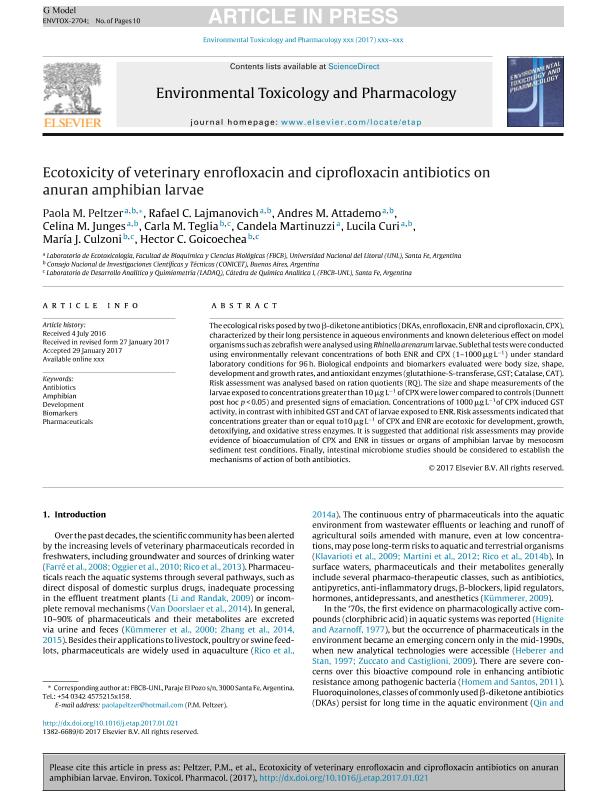Artículo
Ecotoxicity of veterinary enrofloxacin and ciprofloxacin antibiotics on anuran amphibian larvae
Peltzer, Paola ; Lajmanovich, Rafael Carlos
; Lajmanovich, Rafael Carlos ; Attademo, Andres Maximiliano
; Attademo, Andres Maximiliano ; Junges, Celina Maria
; Junges, Celina Maria ; Teglia, Carla Mariela
; Teglia, Carla Mariela ; Martinuzzi, Candela Soledad
; Martinuzzi, Candela Soledad ; Curi, Lucila Marilén
; Curi, Lucila Marilén ; Culzoni, Maria Julia
; Culzoni, Maria Julia ; Goicoechea, Hector Casimiro
; Goicoechea, Hector Casimiro
 ; Lajmanovich, Rafael Carlos
; Lajmanovich, Rafael Carlos ; Attademo, Andres Maximiliano
; Attademo, Andres Maximiliano ; Junges, Celina Maria
; Junges, Celina Maria ; Teglia, Carla Mariela
; Teglia, Carla Mariela ; Martinuzzi, Candela Soledad
; Martinuzzi, Candela Soledad ; Curi, Lucila Marilén
; Curi, Lucila Marilén ; Culzoni, Maria Julia
; Culzoni, Maria Julia ; Goicoechea, Hector Casimiro
; Goicoechea, Hector Casimiro
Fecha de publicación:
01/2017
Editorial:
Elsevier Science
Revista:
Environmental Toxicology and Pharmacology
ISSN:
1382-6689
Idioma:
Inglés
Tipo de recurso:
Artículo publicado
Clasificación temática:
Resumen
The ecological risks posed by two β-diketone antibiotics (DKAs, enrofloxacin, ENR and ciprofloxacin, CPX), characterized by their long persistence in aqueous environments and known deleterious effect on model organisms such as zebrafish were analysed using Rhinella arenarum larvae. Sublethal tests were conducted using environmentally relevant concentrations of both ENR and CPX (1–1000 μg L−1) under standard laboratory conditions for 96 h. Biological endpoints and biomarkers evaluated were body size, shape, development and growth rates, and antioxidant enzymes (glutathione-S-transferase, GST; Catalase, CAT). Risk assessment was analysed based on ration quotients (RQ). The size and shape measurements of the larvae exposed to concentrations greater than 10 μg L−1 of CPX were lower compared to controls (Dunnett post hoc p < 0.05) and presented signs of emaciation. Concentrations of 1000 μg L−1of CPX induced GST activity, in contrast with inhibited GST and CAT of larvae exposed to ENR. Risk assessments indicated that concentrations greater than or equal to10 μg L−1 of CPX and ENR are ecotoxic for development, growth, detoxifying, and oxidative stress enzymes. It is suggested that additional risk assessments may provide evidence of bioaccumulation of CPX and ENR in tissues or organs of amphibian larvae by mesocosm sediment test conditions. Finally, intestinal microbiome studies should be considered to establish the mechanisms of action of both antibiotics.
Palabras clave:
Amphibian
,
Antibiotics
,
Biomarkers
,
Development
,
Pharmaceuticals
Archivos asociados
Licencia
Identificadores
Colecciones
Articulos(CCT - SANTA FE)
Articulos de CTRO.CIENTIFICO TECNOL.CONICET - SANTA FE
Articulos de CTRO.CIENTIFICO TECNOL.CONICET - SANTA FE
Citación
Peltzer, Paola; Lajmanovich, Rafael Carlos; Attademo, Andres Maximiliano; Junges, Celina Maria; Teglia, Carla Mariela; et al.; Ecotoxicity of veterinary enrofloxacin and ciprofloxacin antibiotics on anuran amphibian larvae; Elsevier Science; Environmental Toxicology and Pharmacology; 51; 1-2017; 114-123
Compartir
Altmétricas



